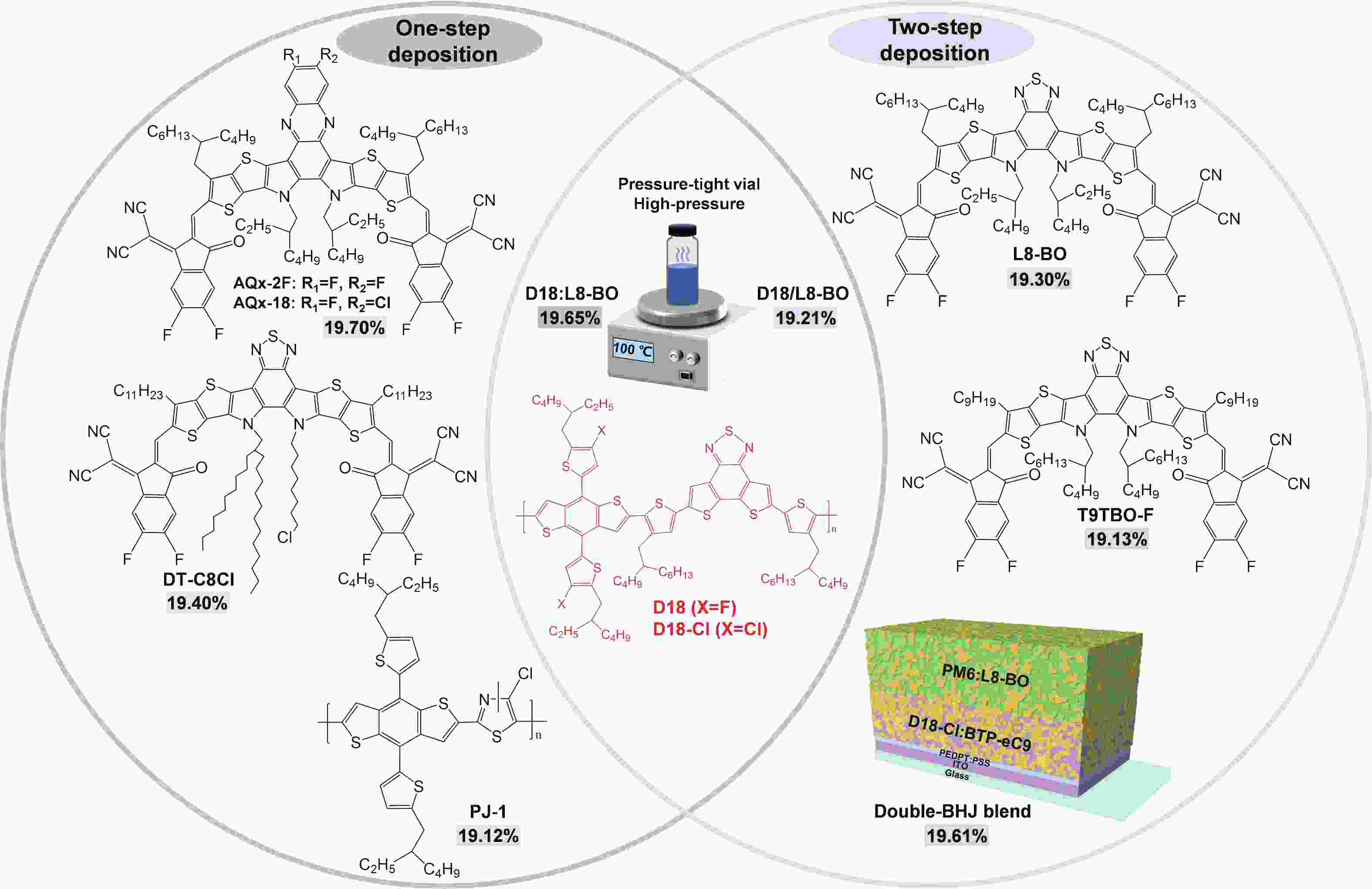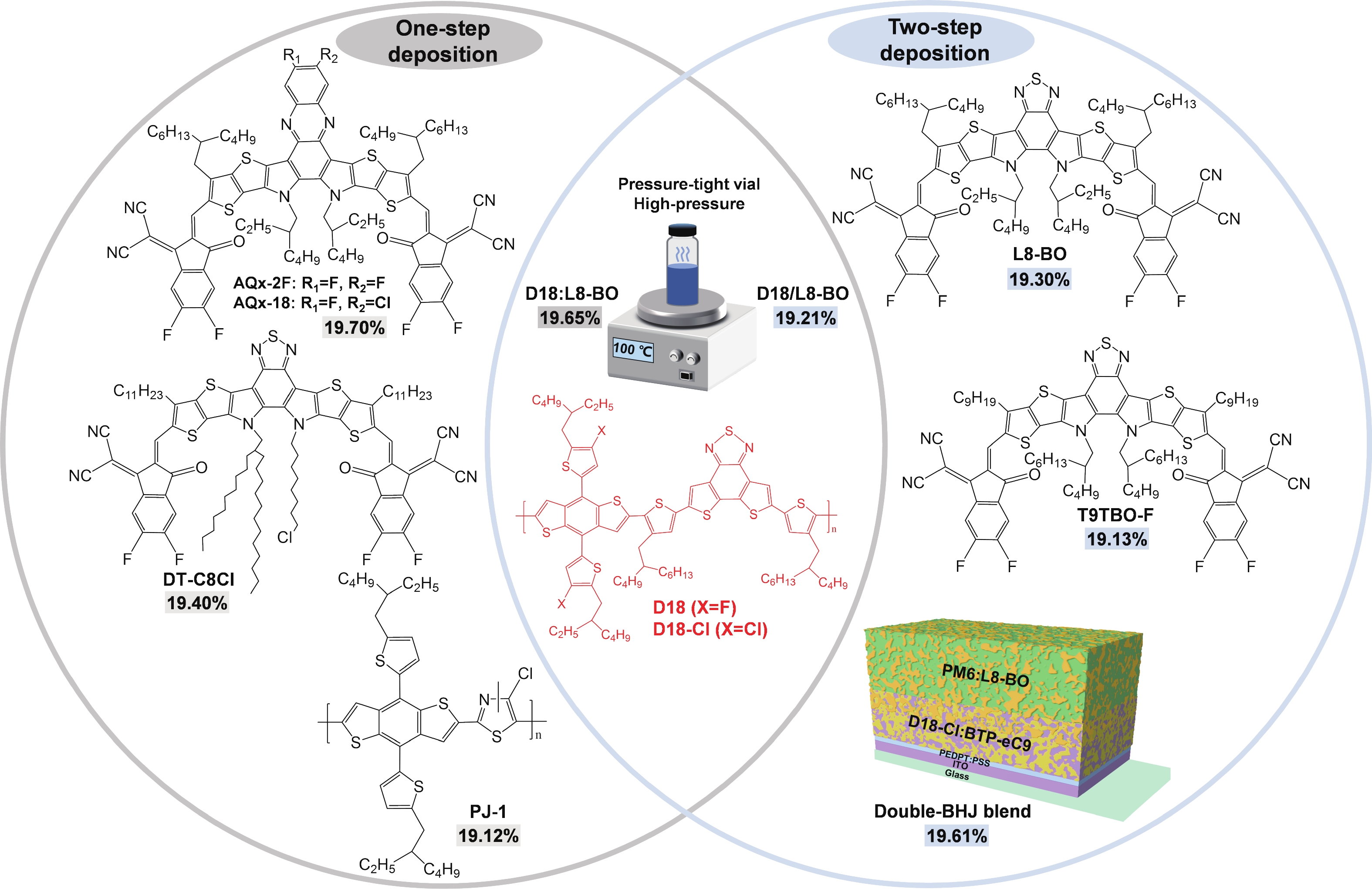| Citation: |
Erming Feng, Chujun Zhang, Jianhui Chang, Hengyue Li, Liming Ding, Junliang Yang. Organic solar cells with D18 or derivatives offer efficiency over 19%[J]. Journal of Semiconductors, 2024, 45(5): 050201. doi: 10.1088/1674-4926/45/5/050201
E M Feng, C J Zhang, J H Chang, H Y Li, L M Ding, J L Yang. Organic solar cells with D18 or derivatives offer efficiency over 19%[J]. J. Semicond, 2024, 45(5): 050201. doi: 10.1088/1674-4926/45/5/050201
Export: BibTex EndNote
|
Organic solar cells with D18 or derivatives offer efficiency over 19%
doi: 10.1088/1674-4926/45/5/050201
More Information-
References
[1] Cheng P, Li G, Zhan X, et al. Next-generation organic photovoltaics based on non-fullerene acceptors. Nat Photonics, 2018, 12, 131 doi: 10.1038/s41566-018-0104-9[2] Feng E, Han Y, Chang J, et al. 26.75 cm2 organic solar modules demonstrate a certified efficiency of 14.34%. J Semicond, 2022, 43, 100501 doi: 10.1088/1674-4926/43/10/100501[3] Bai X, Feng E, Li H, et al. Boosting the photovoltaic performance of doctor-bladed organic solar cells using a low-boiling solvent additive. Org Electron, 2023, 118, 106794 doi: 10.1016/j.orgel.2023.106794[4] Feng E, Zhang C, Chang J, et al. A 16.10% efficiency organic solar module with ultra-narrow interconnections fabricated via nanosecond ultraviolet laser processing. Cell Rep Phys Sci, 2024 doi: 10.1016/j.xcrp.2024.101883[5] Luo Y, Chen X, Xiao Z, et al. A large-bandgap copolymer donor for efficient ternary organic solar cells. Mater Chem Front, 2021, 5, 6139 doi: 10.1039/D1QM00835H[6] Yuan J, Zhang Y, Zhou L, et al. Single-junction organic solar cell with over 15% efficiency using fused-ring acceptor with electron-deficient core. Joule, 2019, 3, 1140 doi: 10.1016/j.joule.2019.01.004[7] Li C, Zhou J, Song J, et al. Non-fullerene acceptors with branched side chains and improved molecular packing to exceed 18% efficiency in organic solar cells. Nat Energy, 2021, 6, 605 doi: 10.1038/s41560-021-00820-x[8] Liu Q, Jiang Y, Jin K, et al. 18% efficiency organic solar cells. Sci Bull, 2020, 65, 272 doi: 10.1016/j.scib.2020.01.001[9] Qin J, Zhang L, Zuo C, et al. A chlorinated copolymer donor demonstrates a 18.13% power conversion efficiency. J Semicond, 2021, 42, 010501 doi: 10.1088/1674-4926/42/1/010501[10] Tang H, Bai Y, Zhao H, et al. Interface engineering for highly efficient organic solar cells. Adv Mater, 2024, 2212236 doi: 10.1002/adma.202212236Citations:18SECTIONS[11] Jin K, Xiao Z, Ding L. 18.69% PCE from organic solar cells. J Semicond, 2021, 42, 060502 doi: 10.1088/1674-4926/42/6/060502[12] Jin K, Xiao Z, Ding L. D18, an eximious solar polymer! J Semicond, 2021, 42, 010502 doi: 10.1088/1674-4926/42/1/010502[13] Li H, Huang K, Dong Y, et al. Efficient organic solar cells with the active layer fabricated from glovebox to ambient condition. Appl Phys Lett, 2020, 117, 133301 doi: 10.1063/5.0021509[14] Zhang G, Lin F R, Qi F, et al. Renewed prospects for organic photovoltaics. Chem Rev, 2022, 122, 14180 doi: 10.1021/acs.chemrev.1c00955[15] Mishra A, Sharma G D. Harnessing the structure-performance relationships in designing non-fused ring acceptors for organic solar cells. Angew Chem Int Ed, 2023, 62, e202219245 doi: 10.1002/anie.202219245[16] Yao H, Hou J. Recent advances in single-junction organic solar cells. Angew Chem Int Ed, 2022, 61, e202209021 doi: 10.1002/anie.202209021[17] Cao J, Nie G, Zhang L, et al. Star polymer donors. J Semicond, 2022, 43, 070201 doi: 10.1088/1674-4926/43/7/070201[18] Cao J, Yi L, Ding L. The origin and evolution of Y6 structure. J Semicond, 2022, 43, 030202 doi: 10.1088/1674-4926/43/3/030202[19] Meng X, Li M, Jin K, et al. A 4-arm small molecule acceptor with high photovoltaic performance. Angew Chem Int Ed, 2022, 61, e202207762 doi: 10.1002/anie.202207762[20] Li P, Meng X, Jin K, et al. Banana-shaped electron acceptors with an electron-rich core fragment and 3d packing capability. Carbon Energy, 2023, 5, e250 doi: 10.1002/cey2.250[21] Meng X, Jin K, Xiao Z, et al. Side chain engineering on D18 polymers yields 18.74% power conversion efficiency. J Semicond, 2021, 42, 100501 doi: 10.1088/1674-4926/42/10/100501[22] Lu H, Liu W, Ran G, et al. High-pressure fabrication of binary organic solar cells with high molecular weight D18 yields record 19.65% efficiency. Angew Chem Int Ed, 2023, 62, e202314420 doi: 10.1002/anie.202314420[23] Zhu L, Zhang M, Xu J, et al. Single-junction organic solar cells with over 19% efficiency enabled by a refined double-fibril network morphology. Nat Mater, 2022, 21, 656 doi: 10.1038/s41563-022-01244-y[24] Tang W, Ding Z, Su Y, et al. Sequentially deposited elastomer-based ternary active layer for high-performance stretchable organic solar cells. Adv Funct Mater, 2024, 2312289 doi: 10.1002/adfm.202312289[25] Qin J, Zhang L, Xiao Z, et al. Over 16% efficiency from thick-film organic solar cells. Sci Bull, 2020, 65, 1979 doi: 10.1016/j.scib.2020.08.027[26] Zhang Y, Zou W, Zhang Y, et al. A record-breaking high efficiency facilitated by hierarchical morphology in all polymer solar cells. J Energy Chem, 2023, 87, 460 doi: 10.1016/j.jechem.2023.08.030[27] Wang J, Wang Y, Xian K, et al. Regulating phase separation kinetics for high-efficiency and mechanically robust all-polymer solar cells. Adv Mater, 2024, 36, 2305424 doi: 10.1002/adma.202305424[28] Kumar G, Chen F C. A review on recent progress in organic photovoltaic devices for indoor applications. J Phys D:Appl Phys, 2023, 56, 353001 doi: 10.1088/1361-6463/acd2e5[29] Suthar R, Dahiya H, Karak S, et al. Indoor organic solar cells for low-power IoT devices: Recent progress, challenges, and applications. J Mater Chem C, 2023, 11, 12486 doi: 10.1039/D3TC02570E[30] Tang H, Liao Z, Karuthedath S, et al. Rationale for highly efficient and outdoor-stable terpolymer solar cells. Energy Environ Sci, 2023, 16, 2056 doi: 10.1039/D3EE00350G[31] Sun C, Lee J W, Tan Z, et al. Regiospecific incorporation of acetylene linker in high-electron mobility dimerized acceptors for organic solar cells with high efficiency (18.8%) and long 1-Sun lifetime (>5000 h). Adv Energy Mater, 2023, 13, 2301283 doi: 10.1002/aenm.202301283[32] Wang Z, Peng Z, Xiao Z, et al. Thermodynamic properties and molecular packing explain performance and processing procedures of three D18: NFA organic solar cells. Adv Mater, 2020, 32, 2005386 doi: 10.1002/adma.202005386[33] Lu H, Ran G, Liu Y, et al. Green-solvent-processed high-performance ternary organic solar cells comprising a highly soluble and fluorescent third component. Adv Funct Mater, 2023, 33, 2301866 doi: 10.1002/adfm.202301866[34] Sun M, Zhang K N, Qiao J W, et al. Overcoming disordered preaggregation in liquid state for highly efficient organic solar cells printed from nonhalogenated solvents. Adv Energy Mater, 2023, 13, 2203465 doi: 10.1002/aenm.202203465[35] Meng L, Liang H, Song G, et al. Tandem organic solar cells with efficiency over 19% via the careful subcell design and optimization. Sci China Chem, 2023, 66, 808 doi: 10.1007/s11426-022-1479-x[36] Liu L, Xiao H, Jin K, et al. 4-Terminal inorganic perovskite/organic tandem solar cells offer 22% efficiency. Nano-Micro Lett, 2022, 15, 23 doi: 10.1007/s40820-022-00995-2[37] Liu L, Xiao Z, Zuo C, et al. Inorganic perovskite/organic tandem solar cells with efficiency over 20%. J Semicond, 2021, 42, 020501 doi: 10.1088/1674-4926/42/2/020501[38] Dong S, Zhang K, Xie B, et al. High-performance large-area organic solar cells enabled by sequential bilayer processing via nonhalogenated solvents. Adv Energy Mater, 2019, 9, 1802832 doi: 10.1002/aenm.201802832[39] Sun R, Guo J, Sun C, et al. A universal layer-by-layer solution-processing approach for efficient non-fullerene organic solar cells. Energy Environ Sci, 2019, 12, 384 doi: 10.1039/C8EE02560F[40] Yang Y, Feng E, Li H, et al. Layer-by-layer slot-die coated high-efficiency organic solar cells processed using twin boiling point solvents under ambient condition. Nano Res, 2021, 14, 4236 doi: 10.1007/s12274-021-3576-8[41] Liu K, Jiang Y, Ran G, et al. 19.7% efficiency binary organic solar cells achieved by selective core fluorination of nonfullerene electron acceptors. Joule, 2024 doi: 10.1016/j.joule.2024.01.005[42] Xu X, Jing W, Meng H, et al. Sequential deposition of multicomponent bulk heterojunctions increases efficiency of organic solar cells. Adv Mater, 2023, 35, 2208997 doi: 10.1002/adma.202208997[43] Chen S, Zhu S, Hong L, et al. Binary organic solar cells with over 19 % efficiency and enhanced morphology stability enabled by asymmetric acceptors. Angew Chem Int Ed, 2024, e202318756 doi: 10.1002/ange.202318756[44] Deng M, Xu X, Duan Y, et al. Y-type non-fullerene acceptors with outer branched side chains and inner cyclohexane side chains for 19.36% efficiency polymer solar cells. Adv Mater, 2023, 35, 2210760 doi: 10.1002/adma.202210760[45] Chen Z, Zhu J, Yang D, et al. Isomerization strategy on a non-fullerene guest acceptor for stable organic solar cells with over 19% efficiency. Energy Environ Sci, 2023, 16, 3119 doi: 10.1039/D3EE01164J[46] Zhang G, Wu Q, Duan Y, et al. Simultaneously improved Jsc and Voc achieving 19.15% efficiency in ternary blend polymer solar cell containing a Y-type acceptor with thiophene based end groups. Chem Eng J, 2023, 476, 146538 doi: 10.1016/j.cej.2023.146538[47] Yao Z, Cao X, Bi X, et al. Complete peripheral fluorination of the small-molecule acceptor in organic solar cells yields efficiency over 19 %. Angew Chem Int Ed, 2023, 62, e202312630 doi: 10.1002/anie.202312630[48] Liu K, Jiang Y, Liu F, et al. Organic solar cells with over 19% efficiency enabled by a 2D-conjugated non-fullerene acceptor featuring favorable electronic and aggregation structures. Adv Mater, 2023, 35, 2300363 doi: 10.1002/adma.202300363[49] Lu H, Wang H, Ran G, et al. Chlorinated thiazole-based low-cost polymer donors for high efficiency binary and ternary organic solar cells. CCS Chem, 2024 doi: 10.31635/ccschem.023.202303239[50] Huang T, Zhang Y, Wang J, et al. Dual-donor organic solar cells with 19.13% efficiency through optimized active layer crystallization behavior. Nano Energy, 2024, 121, 109226 doi: 10.1016/j.nanoen.2023.109226[51] Su Y W, Tsai C E, Liao T C, et al. High-performance organic photovoltaics incorporating bulk heterojunction and p-i-n active layer structures. Sol RRL, 2024, 2300927 doi: 10.1002/solr.202300927[52] Wei Y, Chen Z, Lu G, et al. Binary organic solar cells breaking 19% via manipulating the vertical component distribution. Adv Mater, 2022, 34, 2204718 doi: 10.1002/adma.202204718[53] Chen Q, Huang H, Hu D, et al. Improving the performance of layer-by-layer processed organic solar cells via introducing a wide-bandgap dopant into the upper acceptor layer. Adv Mater, 2023, 35, 2211372 doi: 10.1002/adma.202211372[54] Li Q, Liao X, Sun Y, et al. Intermolecular interactions, morphology, and photovoltaic patterns in p–i–n heterojunction solar cells with fluorine-substituted organic photovoltaic materials. Small, 2024, 2308165 doi: 10.1002/smll.202308165[55] Kan Y, Sun Y, Ren Y, et al. Amino-functionalized graphdiyne derivative as a cathode interface layer with high thickness tolerance for highly efficient organic solar cells. Adv Mater, 2024, 2312635 doi: 10.1002/adma.202312635[56] Gao W, Qi F, Peng Z, et al. Achieving 19% power conversion efficiency in planar-mixed heterojunction organic solar cells using a pseudosymmetric electron acceptor. Adv Mater, 2022, 34, 2202089 doi: 10.1002/adma.202202089[57] Jiang K, Zhang J, Zhong C, et al. Suppressed recombination loss in organic photovoltaics adopting a planar–mixed heterojunction architecture. Nat Energy, 2022, 7, 1076 doi: 10.1038/s41560-022-01138-y[58] Fan B, Zhong W, Gao W, et al. Understanding the role of removable solid additives: Selective interaction contributes to vertical component distributions. Adv Mater, 2023, 35, 2302861 doi: 10.1002/adma.202302861[59] Liu Z, Zhang M, Zhang L, et al. Over 19.1% efficiency for sequentially spin-coated polymer solar cells by employing ternary strategy. Chem Eng J, 2023, 471, 144711 doi: 10.1016/j.cej.2023.144711 -
Proportional views






 DownLoad:
DownLoad:














